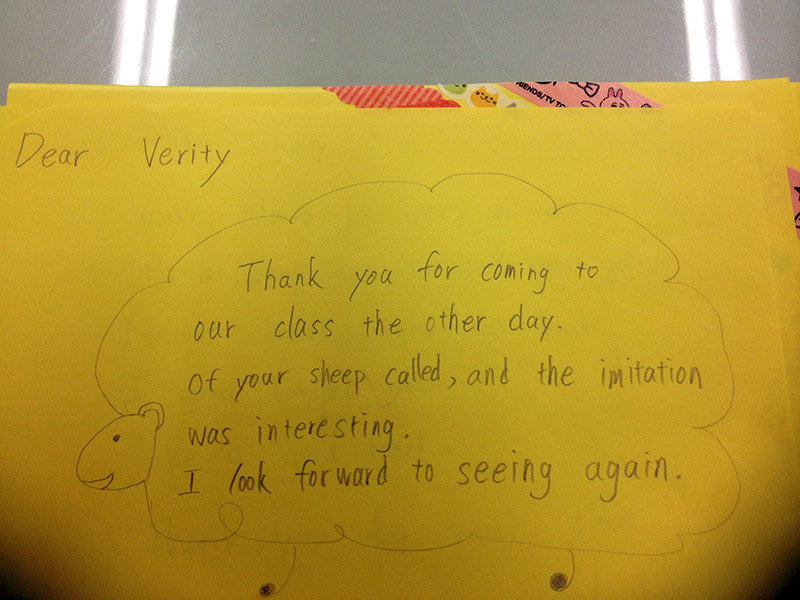Hajimemashite! It's nice to meet you!
If you come to Japan you're going to find yourself saying this quite often. Introductions are very important in Japanese culture. It can be seen as an extension of the Japanese obsession with perfection. Things have to be perfect right from the start and that includes the start of every relationship, whether in business, school, or even casual meetings. It can sometimes seem like the introduction is the most important part of any endeavor. If you've got off on the right foot, all the subsequent steps aren't quite as important. But that introduction… gotta get that right! This is true in jikoshoukai and especially in the ALT self-intro class.
I once attended an English camp where I spotted a tiny error in the program notes for the introductory speech. I pointed it out to the organizers and thought that was the end of it. Problem solved! I was surprised to find the organizers flipping out for the next half hour, trying to work out if they could reprint all the programs before the opening ceremony. I was very confused so I asked a Japanese co-worker why they were so agitated. She explained, "It's because it affects the opening ceremony. We think that if the opening is good, then the whole thing will be good. If the opening is bad, then everything is ruined."
To me that seemed like a lot of pressure to put on the start of something (though actually that camp was a disaster, so maybe they had a point.) Still, it gave me some insight into the importance that Japanese culture places on introductions. The introduction sets the tone for the entire relationship. It's a formalized way of perfecting first impressions. In some ways this is stressful, if you don't know the rules. But luckily the rules are easy to grasp. Once you've got them you can relax.
How to Master the ALT Self-Intro Class

I recently wrote an article for new ALTs (Assistant Language Teachers), offering tips and tricks for success in the classroom. But before ALTs can start proper teaching, they are expected to teach a self-introduction class. While this may seem daunting at first, a little preparation and practice can make anyone a self-intro wizard!
First, don't worry if it goes a bit wrong. The first ones are always dodgy. Take it as a learning experience. My first self-introductions were appalling, mumbling, too long, too focused on me talking, and far too complicated. Now, over 100 self-intro classes later I can literally do one successfully almost on autopilot. The key is to refine it a little each time. Notice which bits got the laughs and which bits got dead silence. Adjust your self-introduction accordingly. Ask JTEs (Japanese Teacher of English) for feedback. They may not all be willing to give any, but a few might have some good advice for you.

Most of my schools didn't have access to any kind of presentation equipment, so I relied on printed pictures. The laminator will be your greatest friend. I put my self-introduction together three years ago and used it over 100 times. Thanks to being laminated it's still going strong. When it comes to pictures, think big – A4 size minimum. Passing pictures around takes time and splits a class' attention when you want to keep that attention on what you're saying. Flags are good, as are other props, especially for younger students. If you love rugby, take a rugby ball. If you have a national animal, take a stuffed toy. Pictures of your family, your pets, favourite foods and hobbies are good staples. Try to find a picture to illustrate each point you want to talk about. Back those pictures up with drawings on the blackboard, however terrible they may be. Fast is more important than beautiful. You can write keywords too, which really helps Japanese students who usually don't get much listening practice, but can read much better.
If you do have access to presentation equipment, go for it! I'd particularly recommend Prezzi, presentation software. It will blow your students' minds. Actually, even PowerPoint will probably blow their minds, especially if you include moving elements. In my experience of rural schools, most JTEs rarely use technology in the classrooms. (Some can't even use Microsoft Word – I wish I was joking.) Given how unusual presentation equipment is in Japanese schools, I'd suggest making a low-tech version as a backup. You never know when a projector won't work, or your power point will bizarrely show upside-down or a teacher will simply be so freaked out by the idea of a presentation that they say no.
So you've got your materials. But what do you say? Try to think back to language classes you took as a child. What topics did you cover? Family, animals, foods, and so on. Make it your own too. What is interesting about you? That can be hard to answer by yourself, so ask friends and family for their opinions.

Now, I'm not saying you should lie to children (fun as that is), but do simplify your life story. Personally, I say, "My family are sheep farmers. This is my favorite sheep, Kevin." I don't say, "My Aunt once rescued some sheep and has since created a paradise on earth for out of luck farm animals. Kevin is an ovine spiritual guru whose wooly coat holds the secret to cosmic happiness, which can be unlocked by petting him." It's simpler. The aim is not to have the kids understand every nuance of your life, but just to have them understand something. Also, this appeals to the kids in my area, many of whom come from farming families. Try to find parts of your life the kids can empathize with. This will take some time. Don't worry about being perfect on your first try.
Throw some questions in there too. When I show the picture of Kevin the Sheep I ask the students, "What animal is this?" Kevin is a very handsome brown sheep, but most sheep in Japan are white, so the answers usually go from dog to bear to cow before settling on sheep. That's more fun for the students than me simply saying, "This is a sheep."
Go to town with gestures too. Mime like your life depends on it. I do an imitation of Kevin the sheep running towards me in a field, which is 100% ridiculous. It always gets a laugh and the kids visibly relax. They aren't so shy about embarrassing themselves, because nothing they do will be as embarrassing as me running around the classroom going "Baaaaaaaa!"
I don't just talk about sheep, (though animals are a good topic for kids since they know a lot of the vocabulary.) I usually start with an explanation of the four countries of the UK. I make it more interesting by explaining that my Dad is from England and my Mum is from Wales (another simplification.) I do this using pictures of my Mum and Dad and making the kids guess who they are before saying "Yes. This is my Father. He has a crazy face." (In the picture I use, he is pulling a very strange expression! Thanks Dad!) Really simple humor using words they know (like crazy) is really important. Thus, without really realizing it, the students learn about the otherwise confusing and dull administrative districts of the UK. (Also, the Welsh flag is badass and gets a mime too – roar!)
I also run through, my favourite food (scones), famous UK food (fish and chips), and my hobby (knitting). Each subject has a picture. I don't work from a script, but instead put the pictures in order and let them remind me of the next topic. If I have a lot of time I throw in that I studied at Oxford University, but I brighten this up for students who have never heard of it by explaining Harry Potter was filmed there. Pop culture can be a useful tool to connect with students. Although this is a self-introduction, that doesn't mean you have to talk about only yourself. This is a great chance to talk about where you come from and your culture.
Self-Intro Class Quiz Finale!

Some teachers will ask you to introduce yourself in 5 minutes. I did a very quick highlights version (name, country, student questions). But sometimes you'll be asked to do your self-introduction for an entire class period. Talking about yourself for 50 minutes is tough on you and on the kids. That's why it's quiz time! There are loads of different ways to run this. I'm going to share what worked for me (at Senior High School level, though it could easily be adapted for Junior High Schools), but you'll be sure to find your own groove.
This entire process is done in English, for both you and the students (this depends on student level, but even at low level schools, it is possible to do it all in English since your pictures and props will help with understanding.) Sometimes it's appropriate for Japanese Teachers to add explanations in Japanese, but usually I found it's not, even at the lowest level schools. Try as hard as you can to stop JTEs from translating every word you say. It kills self-intro classes.
Prepare your quiz questions ahead of time. At first you'll probably need them written down, but your eventual aim should be to do this paperless. Don't be afraid of going off script. It's important to react to the tone of the class.
- At the start, divide the kids into teams of 5 or 6 and have them move their desks together.
- Give each group one big piece of paper.
- Explain that you are going do your self-introduction then there will be a quiz, so the students should write a memo. Memo is a word kids know from katakana (these sorts of words are your friends).
- Do your crazy-awesome self-introduction.
- Explain that the first round of the quiz is the students asking you questions.
- Give them two/three minutes to discuss their questions in a group.
- Use this time to draw the scoreboard, question categories, and points on the blackboard.
- If you have 4 categories then plan on between 3 and 5 questions per category to fill 30 to 50 minutes. As you get more familiar with your self-introduction you'll be able to gauge how many questions you'll need to fill the time.
- Ask the JTE to keep the scores.
- When the 2 minutes thinking time is up, regain the students' attention and tell them to raise their hand to ask a question.
- Answer the students' questions. Give lots of positive feedback ("Great question!" "Nice!")
- If they ask a slightly wonky question eg. "What do you like foods?" repeat the correct version back the them before answering, "What foods do I like? I like agidashi dofu!" (The weirder the Japanese food you say, the happier they'll be.)
- Be prepared for rude questions too and don't get too flustered.
- Give the students 10 points for each question they answer.
- After a few minutes, or when every group has asked a few questions, tell them it's time for you to ask them questions.
- Get ready to slip into a "Game Show Host" persona – think big gestures and big reactions.
- Explain the categories and the points (more points mean a more difficult question).
- Explain that if a team gets a question right they get to choose the next question (they can easily grasp this once they start playing).
- Run through all your questions. Erase the points as the students answer each question.
- Call out the points to the JTE who should be writing them down.
- If there is a very confident team, try to give other teams a chance to answer too by ignoring them for a round.
- At the end add up the scores and give the winners a round of applause.
- Boom! You just ran an awesome self-introduction. As ever, this advice is what has worked for me. Be sure to modify and change as you see fit. If you aren't sure where to start with self-introductions, then you can use this as a framework to build your own style on. There are lots of awesome ways to run a self-introduction. If you have access to IT equipment at school you could do this as a Jeopardy style quiz on a screen. Or you could do it another way entirely. For very young kids, you could consider making answer cards with words or pictures for them to collect when you ask questions about yourself. You could make a comprehension worksheet with questions or in a bingo style for students to fill out as they listen to you. You could get the kids to guess everything about you. I tried several styles before settling on the one I described above.
But beyond all these tips, perhaps the most important thing is the attitude of the JTE towards you. I once had two classes, the same level, same material, same school, same day. The first class went fantastically; kids asked great questions and got really excited. The second class went terribly; the kids stared silently and getting them to ask questions was excruciating. The only difference was the teachers. In the first class the teacher walked in with me and said, "Today we have an ALT with us! She's going to give you her self-introduction!" with a big smile on his face. The second teacher walked into the classroom without saying a word and stood at the back silently. In both cases, the teachers set the tone of the students' reaction. If you can, talk to your JTEs before class to ask them to introduce you. As I said right at the start, introduction is an important part of Japanese culture. The students' crucial first impression of you is formed in part by how the JTE introduces you.
Concluding the Introduction to Introductions

All that said, don't let all this perceived pressure on self-introduction freak you out. When you first arrive in Japan things can be a little overwhelming. If you can get your Japanese self-introduction mostly memorized you'll be fine. People will be forgiving, even if you flub it. Prepare your English self-intro class, but also be prepared to change it as you find your ALT feet. Don't worry; you'll have lots and lots and lots of opportunities to practice the art of jikoshoukai. You'll be a master in no time!
